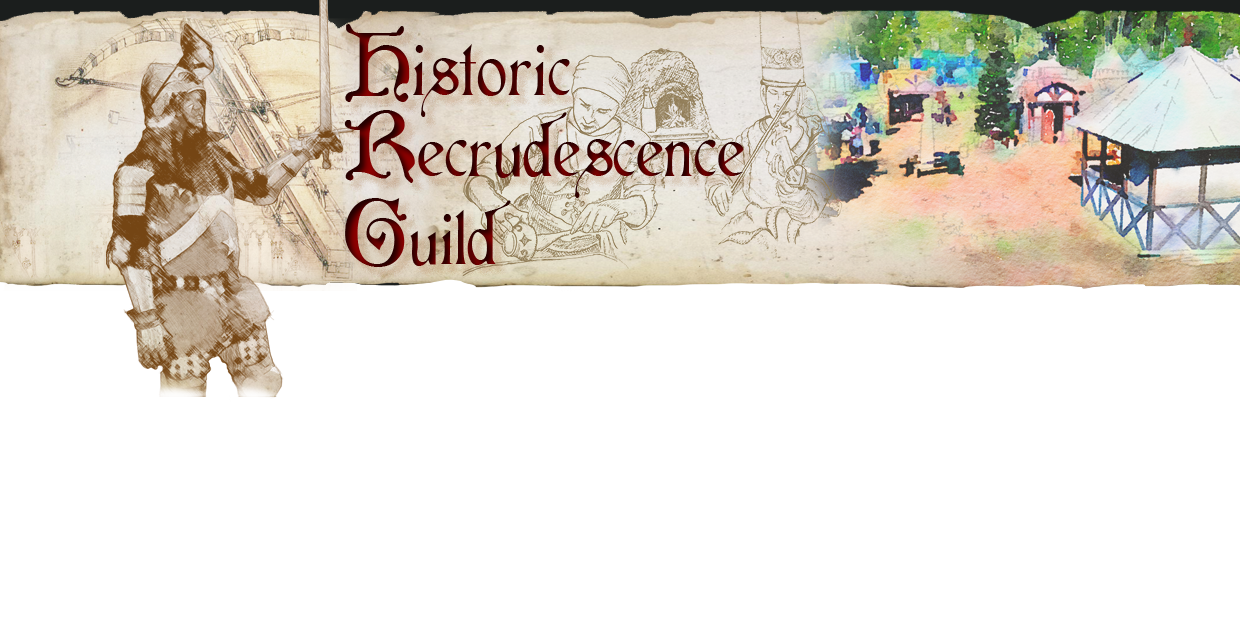
If you are interested in joining the HRG, please contact us: hrg@gci.net
Just so you have a little information on what you'll eventually need, here is a list of period clothing pieces and other items that you'll eventually need. You do NOT need to get these items completely on your own before you can contact us. On the contrary, please get in touch with us first. It may be possible for you to borrow clothing and participate first, then decide what exactly you want to do, and THEN get your own gear.
The HRG's current presentation at the Three Barons' Fair shows an English market town of 1388. This is a town near a larger port town, so a visitor can expect to see some variety in social classes and occupations, as well as people who may be traveling between the port town and other parts of England.
What you need is determined by what you want to do as a living historian. If you are interested in being a military character, you will need different types of clothing and equipment than if you are interested in being a baker. The items of clothing you need may be the same, but the fabric, the quality and the style may be very different. Fabrics are generally linen for chemises, shirts, headwraps, and sometimes for kirtles, and wool for most other things.
For 1388, the era we have been doing most recently:
Women:
chemise (also called a smock) -- this is made of linen and is your underwear
gown
or kirtle - may be of linen or wool
surcoat of some type - there are sideless surcoats, sleeveless surcoats,
and other styles; the cotehardie is another option
head wrap
and cap or hat or hood - there are choices!
hose (stockings) - knee length, made of wool, with garters to
hold them up
probably an apron
a cloak or just a large piece of warm cloth to wrap around yourself
shoes - we have sources
belt and purse or pouch
Men:
shirt and braies - made of linen; this is your underwear
hose - wool has been documented
cote or tunic - linen or wool
cotehardie or surcote
hat or cap or hood
a cloak or just a large piece of warm cloth to wrap around yourself
shoes or boots- we have sources
belt and purse or pouch
Personal gear: cup (pottery, wood, or pewter), bowl (pottery, wood or pewter), spoon (wood or horn), eating knife, and perhaps a basket for carrying everything.
All of the above are the very basic materials you will need to wear, and eat dinner.
You will want to acquire the tools of whatever trade you practice or demonstrate. You may start by helping someone else.
Other personal gear that might be useful would include: a comb (wood or horn), linen towel, candle (beeswax or tallow), flint and steel, sewing kit (see separate list below), honing stone andpolishing kit (for weapons), rosary, pouches and baskets for carrying materials.
Other random useful things:
paper, sealing wax, quills, ink, string, beeswax, bandages
(some of the item lists above were adapted from here: http://www.medievalproductions.nl/compagnie_de_ordonnance/baggage.html)
Sewing kit:
needles, scissors, shears, thimble, wooden bobbins on which to wind thread in a variety of types and colors, awls, buttons, material to use as patches, pins, beeswax, measuring tape, chalk, charcoal,
Many of the sewing kit items need to come from specialty reproduction stores.
(sewing kit list adapted from here: http://livinghistory.co.uk/forums/viewtopic.php?t=6870)
Home | Events | Research and Experiments | HRG in the Schools | Links | Email us:hrg@gci.net